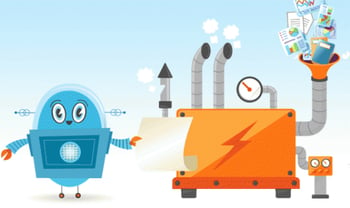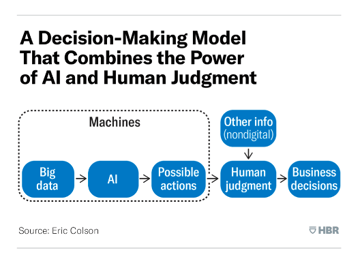The best decision-making model for healthy business growth
Data-driven decision making is all the rage in business. Do you want to fuel growth? Data-driven decision making! But what if there are other viable options to consider?
Exploring options beyond data-driven decision making
In this HBR article, Eric Colson argues that data is of course critical to the decision-making process. But it is only half the equation. To make full use of data, we should consider how data is processed. With that in mind, Colson evaluates the pros and cons of the following four models:
|
Model |
Description |
|
Human-driven |
Humans use their judgement, intuition, and previous experience to make decisions. |
|
Data-driven |
Humans make decisions based on summarized sets of data. |
|
AI-driven |
Machines make decisions by analyzing big data sets. |
|
AI-Plus-Human-driven |
First machines analyze big data and provide a limited set of best options. Then humans use nondigital information to choose which option is the best final decision. |
Prior to reading Colson’s article, I would have said we should strive to be data-driven. However, Colson convinced me that AI-Plus-Human is the ideal model. Here’s why:
|
Leverages data |
Primary processor |
Considers nondigital |
|
|
Human-driven |
❌ | 👵 | ✅ |
|
Data-driven |
✅ | 👵 | ✅ |
|
AI-driven |
✅ | 🤖 | ❌ |
|
AI-Plus-Human-driven |
✅ | 🤖 | ✅ |
As the chart shows, both human-driven and data-driven models still rely on humans as the primary processor. This means decisions made with those models are at risk of being tainted by human cognitive biases.
I’m guessing we’ve all witnessed a laughable “data-driven decision" that was in truth the result of confirmation bias or anchoring bias.
AI vs humans?
So, if we want to minimize cognitive biases, we should gravitate toward a model that leverages AI as the primary processor. Asking machines to crunch big data and arrive at the obvious answer seems like...well, the obvious answer…
 The one downside to using a pure AI-driven model is the potential of missing nondigital information. Machines can’t adjust in real time when your internal champion leaves their company. Or when your customer tells you they just had a budget cut.
The one downside to using a pure AI-driven model is the potential of missing nondigital information. Machines can’t adjust in real time when your internal champion leaves their company. Or when your customer tells you they just had a budget cut.
This is precisely when you want the awesome people you hired to be part of the complex decision-making process. Humans are better at understanding both the importance and potential impact of nondigital information. This is, after all, what it means to be human.
Let's try AI + humans!
This leaves AI-plus-Human as the ideal. We should let machines crunch the big data, identify patterns, and distill complication to a small set of best next steps. Machines are better suited than humans for this kind of work.
Whereas humans are better suited to review a small set of options and choose the best solution based on any nondigital information available to us.
This is how Colson visualizes the AI-Plus-Human model:
In my opinion, this decision-making model incorporates the best of all models. It also makes the most intuitive sense because it asks both humans and machines to play to their strengths.
In perhaps a less-than-surprising-twist, another reason I like this model is it closely aligns to the solution we’re building at Tingono. If the AI-Plus-Human model makes sense to you and you’d like to boost your revenue retention, let’s talk!





